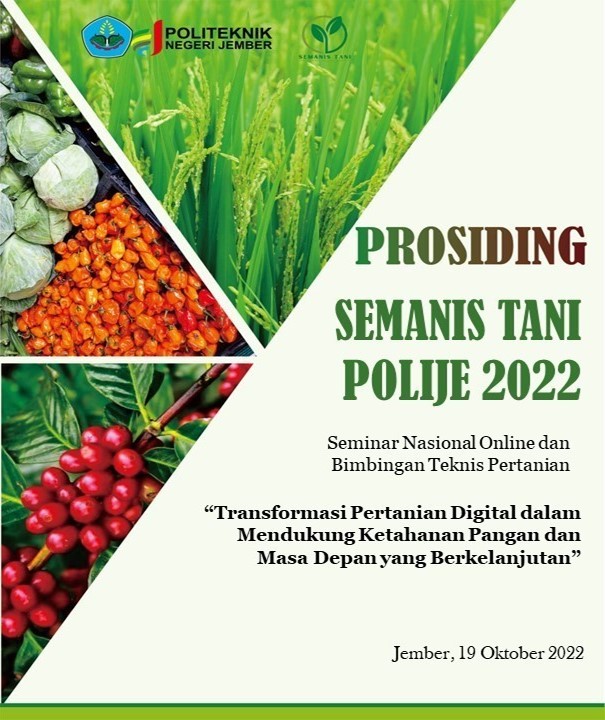UJI KETAHANAN TIGA VARIETAS PISANG (Musa sp.) TERHADAP ISOLAST BANANA BUNCHY TOP VIRUS (BBTV)
DOI:
https://doi.org/10.25047/agropross.2022.306Kata Kunci:
Banana, Banana Bunchy Top Virus, Pentalonia nigronervosa, polymerase chain reaction, Resilience, SymptomAbstrak
Banana is a horticultural crop that has economic value and is widely cultivated in tropical countries. Banana Bunchy Top Virus (BBTV) is the cause of dwarf disease in banana plants (Musa. sp). The vector for the spread of this banana dwarf disease is the banana aphid (Pentalonia nigronervosa). BBTV has been reported in various regions of Indonesia, having been reported in Bengkulu in 2020. However, data on the resistance of BBTV infections in Indonesia are still very limited. This study aimed to evaluate the resistance of three types of bananas (Barangan, Kepok, and Ambon Hijau) to BBTV infection. In this study, two treatments were carried out, namely inoculated and without BBTV virus inoculation with three types of bananas. BBTV detection was carried out using the PCR method. BBTV transmission using aphids succeeded in infecting the test plants with a disease incidence of 12.5% to 75.0% at 30 DAI. The most common symptom seen is, slightly yellowed leaf edges. the severity of BBTV on the Barangan banana plant was 20.83%, kepok was 4.17% and Ambon Hijau was 25.00%. Samples on the leaves of the test banana plant that showed symptoms of BBTV were taken for detection using Polymerase Chain Reaction (PCR) with a pair of related NSP primers in the BBTV genome with a size of ± 500 bp. The results of the detection of BBTV virus showed that the types of bananas that were resistant to BBTV were Kepok bananas, Barangan bananas and Ambon Hijau types which showed moderate resistance to BBTV
Unduhan
Referensi
Agrios. G.N. 1996. Ilmu Penyakit Tumbuhan. Edisi ketiga. Gadjah Mada University Press.Yogyakarta.
Agrios. G.N. 2005. Plant pathology (5th ed). Elsevier Academic Press.
Badan Pusat Statistik. 2020. Statistik Tanaman Buah-Buahan dan Sayuran. Jakarta: BPS/ (diunduh 2020 Januari 2). Tersedia pada: https:///www.bps.go.id.
Blomme G, Ploetz R, Jones D, De Langhe E, Price N, Gold C, Geering A, Karamura D, Pillay M, et al. 2013. A historical overview of the appearance and spread of Musa pests and pathogens on the African continent: highlighting the importance of clean Musa planting materials and quarantine measures. The Annals of Applied Biology. 162: 4 26.
Chiaki Y. Nasir N. Herwina H. Jumjunidang. Sonoda S. Fukumoto T. Nakamura M. Iwai H. 2015. Genetic structure & diversity of the Banana bunchy top virus population on Sumatera Isl&, Indonesia. Eur. J. Plant Pathol. 143, 113–122. E-ISSN: 1573- 8469.
Doyle JJ, Doyle JJ. 1987. A rapid DNA isolation procedure for small quantities of fresh leaf tissue. Phytochem Bull. 19:11-19. Doyle JJ, Doyle JJ. 1987. A rapid DNA isolation procedure for small quantities of fresh leaf tissue. Phytochem Bull. 19:11-19.
Food and Agriculture Organization of the United Nations. 2020. Medium Term Outlook : Prospect for Global Production and Trade in Bananas and Tropical Fruits. Rome
Furuya N, Somowiyarjo S, Natsuaki KT. 2004. Virus detection from local banana cultivars and the first molecular characterization of banana bunchy top virus in Indonesia. Jour. Agri. Sci. Tokyo Univ. of Agric. 49(3): 75-81.
Hapsari L, Masrum A. 2012. Preliminary screening resistance of musa germplasm for banana bunchy top disease in Purwodadi Botanic Garden, Pasuruan, East Java. Buletin Kebun Raya. 15(2): 57-70.
Hooks CRR, Manandhar R, Perez EP, Wang KH, Almeida RPP. 2009. Comparative susceptibility of two banana cultivars to Banana bunchy top virus under laboratory and field environments. Journal of Economic Entomology. 102(3): 897-904.
Irwansyah, Sofian, & Akhsan N. 2019. Identification of Characteristics of Banana Bunchy Top Virus (BBTV) Symptoms & Intensity on Banana Plants in Several Districts in Kutai Kartanegara Regency. Jurnal Agroekoteknologi Tropika Lembab 2(1): 55 60.
Kumar PL, Selvarajan R, Iskra-Caruanan M, Chabannes M, Hanna R. 2016. Biology, etiology, and control of virus diseases of banana and plantain. Advances in Virus Research. 91: 229-269.
Leiwakabessy, M., S Nurulita, & SH Hidayat. 2017. Disease Incidence & Molecular Analysis of Banana bunchy top virus in Bogor, Jawa Barat. In Efendi D, Maharijaya A (eds). The Future of Tropical Horticulture. International Proceeding on Tropical 102 Horticulture 2016: The Future of Tropical Horticulture. Bogor, Indonesia, November 28–29, 2016.
Nurhadi A., & L. Setyobudi. 2000. Status of banana and citrus viral diseases in Indonesia. Di dalam: Molina AB, Roa VN, Bay-Petersen J, Carpio At, joven JEA, editor. Managing Banana and Citrus Diseases. Proceeding of a Regional Workshop on Disease-free Planting Materials; Davao City (Philippines), 4-16 October 1998. Davao City: International Plant Genetic Resources Institute. Pages 135-148.
Pinili, M.S., D.N. Nyana, G. Suastika, & K.T. Natsuaki. 2011. Molecular Analysis of Banana bunchy top virus First Isolatd in Bali, Indonesia. J. Agric. Sci., Tokyo Univ. Agric. 56, 125–134.
Suparman, S., Nurhayati, N., & Setyawaty, A. 2017. Preferensi dan Kecocokan Inang Pentalonia nigronervosa Coquerel (Hemiptera: Aphididae) terhadap Berbagai Varietas Pisang. Jurnal Entomologi Indonesia. 8 (2) : 73–84.
Sutrawati, M and S. Ginting. 2020. First Report of Banana Bunchy Top Disease on Banana in Bengkulu. Agritropica: Journal of Agricultural Science. 3(2): 82-87. Doi: https://doi.org/10.31186/Jagritropica.3.2.82-87.
Unduhan
Diterbitkan
Cara Mengutip
Terbitan
Bagian
Lisensi
Hak Cipta (c) 2022 Dilla Nurul Wahidah, Mimi Sutrawati, Nadrawati

Artikel ini berlisensi Creative Commons Attribution 4.0 International License.
Hak cipta (Copyright) artikel yang dipublikasikan di Agropross : National Conference Proceedings of Agriculture dipegang oleh penulis (Copyright by Authors) di bawah Creative Commons Attribution 4.0 International License (CC-BY). Sehingga penulis tidak memerlukan perjanjian pengalihan hak cipta yang harus diserahkan kepada redaksi.






